Miniature Paintings of India – Chronicling History Through the Ages
At a distance, they are beautiful. On closer examination, they are phenomenal, unravelling stories captured with infinitesimal, intricate details. The world of Miniature Paintings is a kaleidoscope of history, scriptures and the lives of people through the ages.
 A Mughal miniature painting; Image Source: blog.emamichisel.com
A Mughal miniature painting; Image Source: blog.emamichisel.com
The Devil is in the Detail
Defined by delicate brushwork, a mélange of colours, and graceful forms, miniature paintings are so delicate, that even today, with so much modernization, squirrel hair is used to create the brushes used in this art form. Each painting abounds with fine photographic details, capturing even the hair on a character.
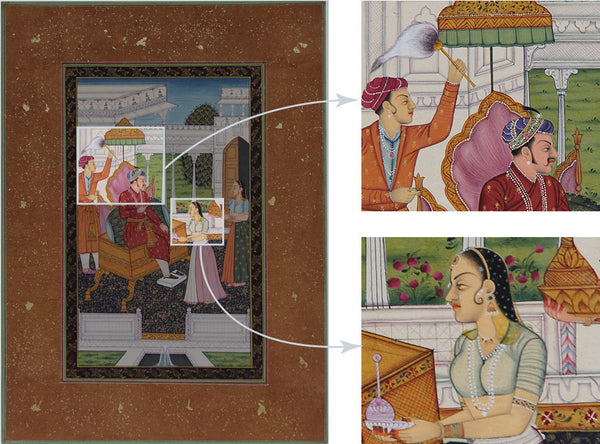 A highly detailed miniature painting depicting an emperor and attendants
A highly detailed miniature painting depicting an emperor and attendants
Click to purchase on Artisera
Miniature art is an intense labour of love illustrated on a range of materials like palm leaves, paper, wood, marble, ivory panels and cloth. Organic and natural minerals like stone dust, real gold and silver dusts are used to create the exquisite colours. Even the paper used is special; polished with stone to render a smooth non porous surface.
Origin of Indian Miniature Paintings
The earliest Miniature paintings in India can be traced back to the 7th century AD, when they flourished under the patronage of the Palas of Bengal. Buddhist texts and scriptures were illustrated on 3-inch-wide palm leaf manuscripts, with images of Buddhist deities. Pala art was defined by subdued colours and sinuous lines, evocative of the murals in Ajanta.
 Female Incarnation of Buddha - Mamaki, from the Pala School, late 11th century.
Female Incarnation of Buddha - Mamaki, from the Pala School, late 11th century.
Image Source: harekrsna.com
While it was Buddhism in the east, it was Jainism that inspired the miniature artistic movement of the Western Indian style of miniature painting. This form prevailed in the regions of Rajasthan, Gujarat and Malwa, from the 12th-16th century AD. Jain manuscripts were illustrated using exaggerated physical traits, vigorous lines and bold colours.
 Miniature painting from a Kalpasutra manuscript, depicting Ganadhara Sudharma.
Miniature painting from a Kalpasutra manuscript, depicting Ganadhara Sudharma.
Image source: herenow4u.net
With the advent of Persian influences in the 15th century, paper replaced palm leaves, while hunting scenes and varied facial types started appearing along with the use of rich aquamarine blues and golds.
 15th century miniature painting from the Atmananda Jain Gnana Mandir, Baroda.
15th century miniature painting from the Atmananda Jain Gnana Mandir, Baroda.
Image source: herenow4u.net
The Mughal Influence
Miniature Art in India truly thrived under the Mughals (16th-18th century AD), defining a rich period in the history of Indian art. The Mughal style of painting was an amalgamation of religion, culture and tradition. Persian styles melded with local Indian art to create a highly detailed, rich art form.
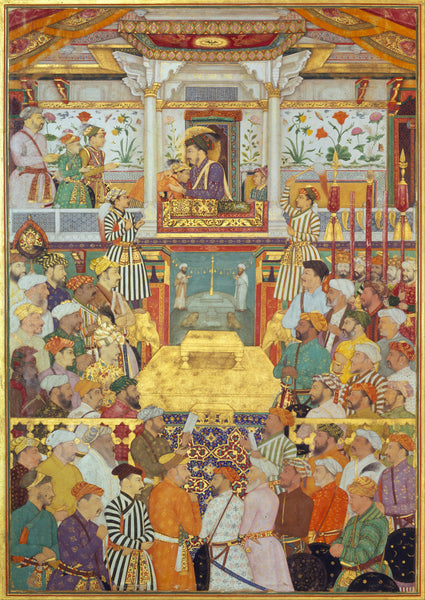 A miniature painting from the Padshahnama, depicting Shah Jahan receiving his sons during his accession ceremony in 1628
A miniature painting from the Padshahnama, depicting Shah Jahan receiving his sons during his accession ceremony in 1628
Under Emperor Akbar, portraitures documenting palace life and the various achievements of royalty became a prominent feature. After him Emperor Jahangir’s reign saw more refinement and charm in the style along with the introduction of many elements of nature. European paintings techniques such as shading and perspectives were also introduced at a later stage within these paintings.
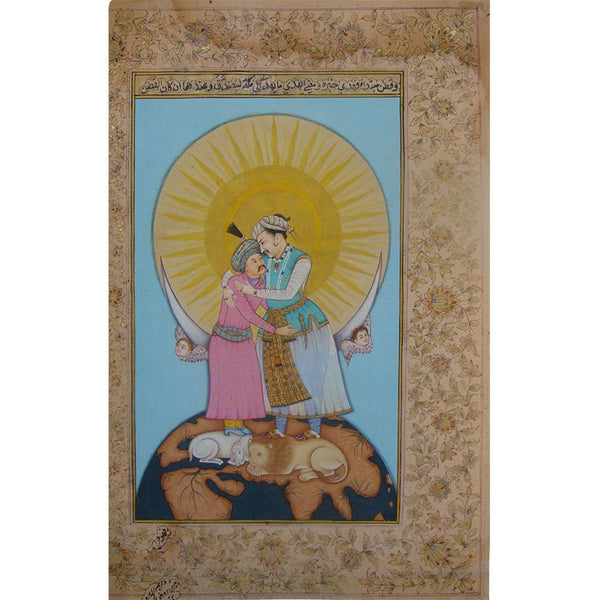 Jahangir with Abbas I of Persia. With angels holding up the sun, this is a typical example of the influence of European Art in Mughal Miniature Paintings
Jahangir with Abbas I of Persia. With angels holding up the sun, this is a typical example of the influence of European Art in Mughal Miniature Paintings
Rajasthani Miniature Art and Pahari Art
Due to decreased patronage during the reign of Aurangzeb, many artists proficient in Mughal Miniature Art migrated to other princely courts. Subsequently, Rajput miniature painting developed in the modern day Rajasthan in the 17th-18th century.
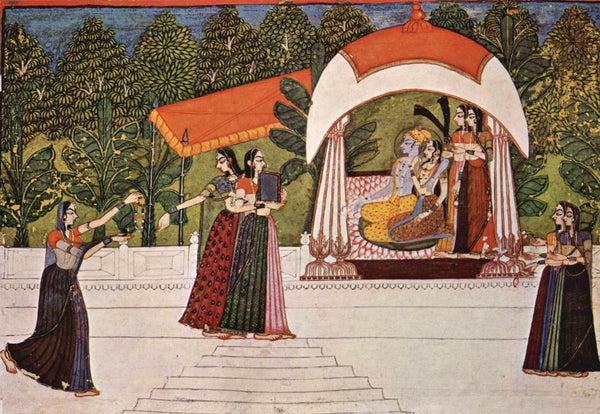 An 18th-century Rajput painting by renowned miniature artist Nihal Chand
An 18th-century Rajput painting by renowned miniature artist Nihal Chand
Unlike Mughal miniature art, which depicted royal life, Rajasthani miniatures centered around the love stories of Lord Krishna and the mythological literature of Ramayana and Mahabharata, created as manuscripts and decorations on the walls of havelis and forts. Many distinct schools of Rajasthani miniature art were established, like the schools of Malwa, Mewar, Marwar, Bundi-Kota, Kishangarh and Amber.
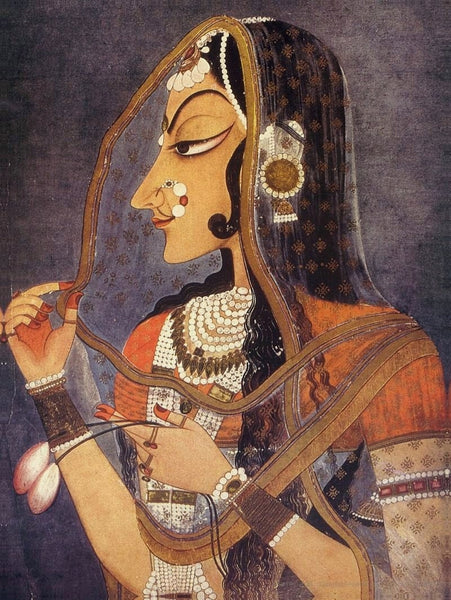 The Kishangarh style is noted for highly exaggerated features like long necks, large, almond shaped eyes, and long fingers
The Kishangarh style is noted for highly exaggerated features like long necks, large, almond shaped eyes, and long fingers
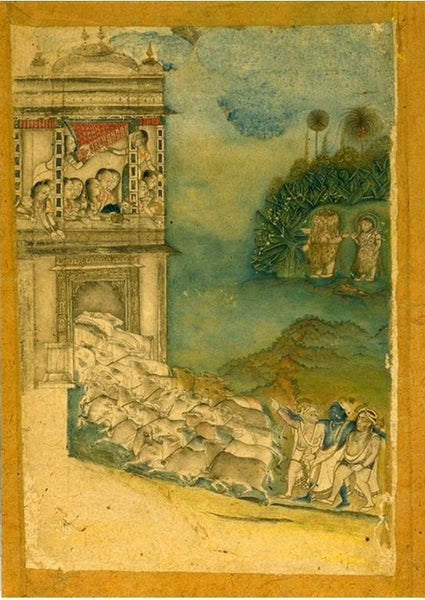 Godhuli - Hour of Cowdust, Mewar School, ca. 1813. Krishna and his fellow cowherds bring home the cows in the evening
Godhuli - Hour of Cowdust, Mewar School, ca. 1813. Krishna and his fellow cowherds bring home the cows in the evening
Another style that evolved under the patronage of the Rajputs, was the Pahari style in the mountain regions located between Jammu and Himachal Pradesh. The Pahari school developed as an assimilation of Mughal miniature art and Vaishnavite stories.
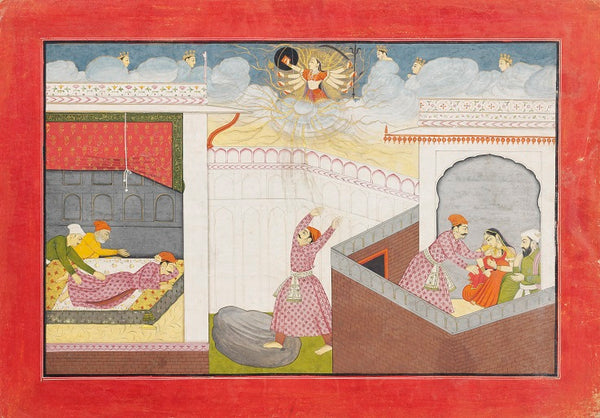 An illustration to the Bhagavata Purana: Durga’s warning given to Kamsa, Pahari style, c.1760–65.
An illustration to the Bhagavata Purana: Durga’s warning given to Kamsa, Pahari style, c.1760–65.
Image source: christies.com
There are various schools of Pahari art – the bold Basohli art with its use of monochrome colours and multi-floor structures, the delicate Kangra style with its lyrical portrayal of naturalism and ‘sringar’, and other schools like Guler and Kulu-Mandi.
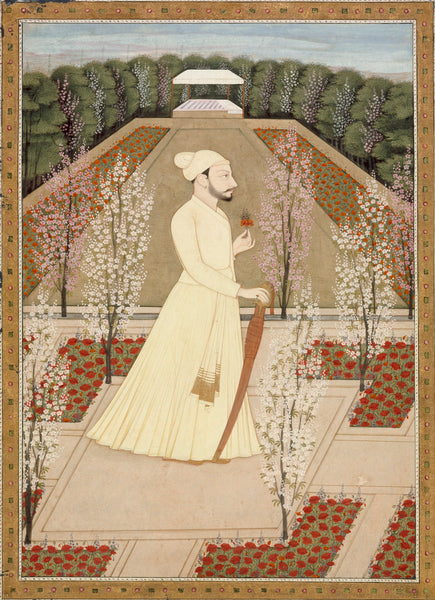 Portrait of Raja Amrit Pal of Basohli, under whom the Basohli style of art flourished
Portrait of Raja Amrit Pal of Basohli, under whom the Basohli style of art flourished
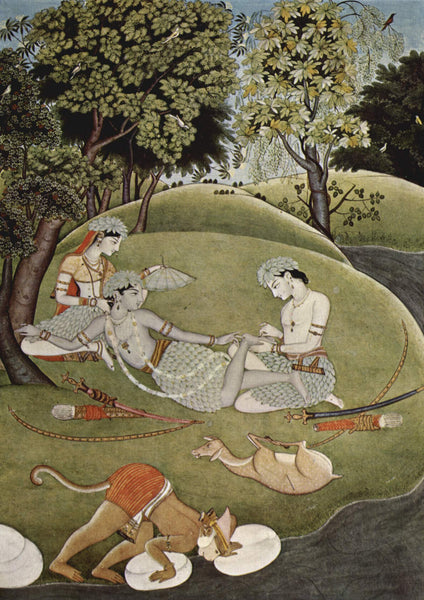 Rama and Sita in the Forest, 1780, Kangra Style of Art
Rama and Sita in the Forest, 1780, Kangra Style of Art
Deccani Style
The Deccani style refers to the miniature art style that was practiced in Bijapur, Ahmednagar, Golkonda and Hyderabad from the 16th-19th century. In the beginning, this style developed independent of Mughal influences. It was an art form that was an idiom of Islamic painting combining European, Iranian and Turkish influences. Paintings of this era revolved around text illumination and decoration of the Holy Quran and the Surahs. Later, more indigenous art forms, romantic elements and Mughal art were amalgamated into the art form.
 Left: Golkonda Style: Raga Kakubha, c.1720; Right: Bijapur Style: Sultan Abdulla Qutb Shah, c.1940.
Left: Golkonda Style: Raga Kakubha, c.1720; Right: Bijapur Style: Sultan Abdulla Qutb Shah, c.1940.
Image source: indiapicks.com
Today, a lot of the preserved miniature paintings are found in museums and in old Rajasthani forts. The art is still practiced in a few regions in India, sometimes under the patronage of royal families, but not with the same level of detail as the original paintings. Though its practice may have waned, miniature art has a distinguished place in history, as a chronicler of knowledge passed through the ages.

















































































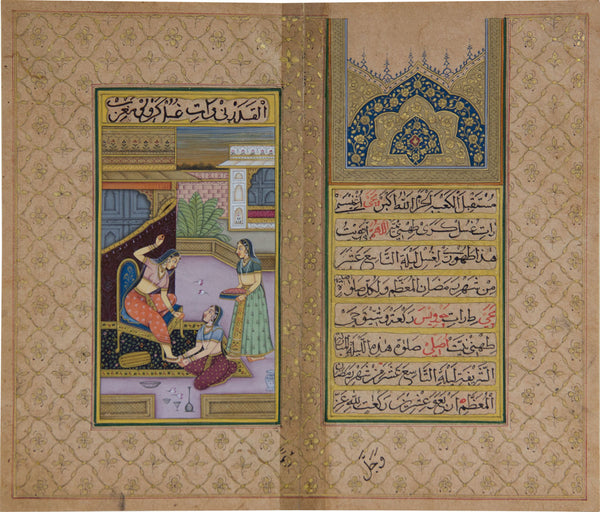 Miniature painting with calligraphy, featuring a lady with two attendants.
Miniature painting with calligraphy, featuring a lady with two attendants. 





